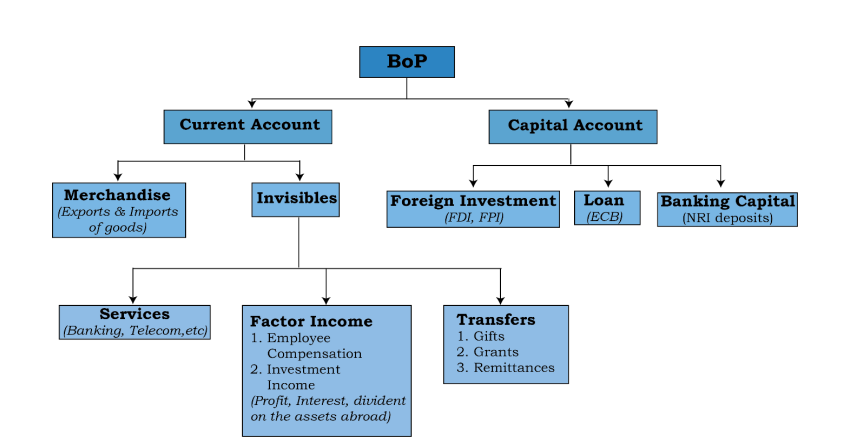Balance of Payments (BoP) and Exchange Rates
Balance of Payments (BoP) and Exchange Rates
Balance of Payments (BoP)
What is the BoP?
- Definition: A record of all economic transactions between a country and the rest of the world over a specific period (usually a year).
- Key Purpose: Summarizes a country's international financial dealings.
Components of the BoP
-
Current Account:
- Definition: Records transactions related to trade in goods and services, income, and current transfers.
-
Key Elements:
-
Trade Balance: Difference between a country's exports and imports of goods.
- Trade Surplus: Exports > Imports
- Trade Deficit: Imports > Exports
- Services: Trade in services (e.g., tourism, financial services, transportation).
- Income: Payments of income from abroad and vice-versa (e.g., wages, dividends, interest).
- Current Transfers: Unilateral transfers (e.g., foreign aid, remittances).
-
Trade Balance: Difference between a country's exports and imports of goods.
- Significance: Often considered the most important part of the BoP as it reflects a country's competitiveness.
-
Capital Account:
- Definition: Records transactions related to capital flows.
-
Key Elements:
- Foreign Direct Investment (FDI): Investment made by a company in a foreign country.
- Portfolio Investment: Purchase of financial assets (e.g., bonds and shares) in a foreign country.
- Other Investments: Loans, bank deposits, etc.
- Significance: Indicates how a country is financing its current account balance.
-
Financial Account
- Definition: Records transactions related to financial assets and liabilities.
-
Key Elements:
- Direct investment (same as capital account)
- Portfolio Investment (same as capital account)
- Reserve Assets - foreign assets controlled by central banks
-
Balancing Item (Errors and Omissions):
- Purpose: Account for errors and omissions made while compiling the BoP.
- Significance: Ensures the BoP always balances, as in theory, the total inflows and outflows must be equal.
- Central Bank Foreign Currency Reserves:
Balance of Payments Equilibrium
- Key Principle: For the BoP to balance, the sum of the Current Account Balance must equal the Financial Account Balance ( plus or minus the balancing item, and changes in the central bank foreign currency reserves).
- Implications: A current account deficit (more imports than exports) must be financed by a net capital and financial inflow, and vice versa.
Exchange Rates
What is an Exchange Rate?
- Definition: The price of one currency in terms of another.
- Significance: Critical for international trade, competitiveness, and a country's economic position.
Impact of Exchange Rate Fluctuations
-
Currency Appreciation (Value Rises):
- Effect on Exports: Exports become more expensive for foreign buyers, potentially reducing demand (unless domestic producers lower prices).
- Effect on Imports: Imports become cheaper, increasing their competitiveness in the domestic market.
- Impact on Trade Balance: Reduces a trade surplus or worsens a trade deficit.
- Overall Impact: Makes domestic products less competitive internationally, impacting businesses that rely on exports.
-
Currency Depreciation (Value Falls):
- Effect on Exports: Exports become cheaper for foreign buyers, potentially increasing demand.
- Effect on Imports: Imports become more expensive, decreasing their competitiveness in the domestic market.
- Impact on Trade Balance: Improves a trade surplus or reduces a trade deficit.
- Overall Impact: Makes domestic products more competitive internationally, potentially helping businesses reliant on exports.
Factors Influencing Exchange Rates:
- Relative Inflation Rates: Higher inflation typically leads to currency depreciation.
- Interest Rates: Higher interest rates can attract foreign investment, causing appreciation.
- Economic Growth: Stronger economic growth can strengthen a currency.
- Political Stability: Political instability can weaken a currency.
- Speculation: Market expectations can influence short-term fluctuations.
- Government Intervention: Central banks can intervene in the foreign exchange market to manage exchange rates.
The "Right" Exchange Rate
- Key Idea: There is no single "right" exchange rate, as different levels can benefit different industries or objectives.
-
Considerations:
- Competitiveness: A weaker exchange rate can boost exports but hurt consumers through higher import prices.
- Inflation: A weaker exchange rate can lead to higher inflation by raising import costs.
- Capital Flows: A strong exchange rate can attract foreign investment but might harm exporters.
- Economic Goals: Governments need to balance these factors to achieve their economic goals.
In Summary
The Balance of Payments (BoP) is a crucial record of a country's financial interactions with the rest of the world. Exchange rates play a key role in international competitiveness and a country's economic standing, with a currency's value affecting export demand and import costs. Understanding how these two interact is essential for informed economic analysis and policy decisions.

